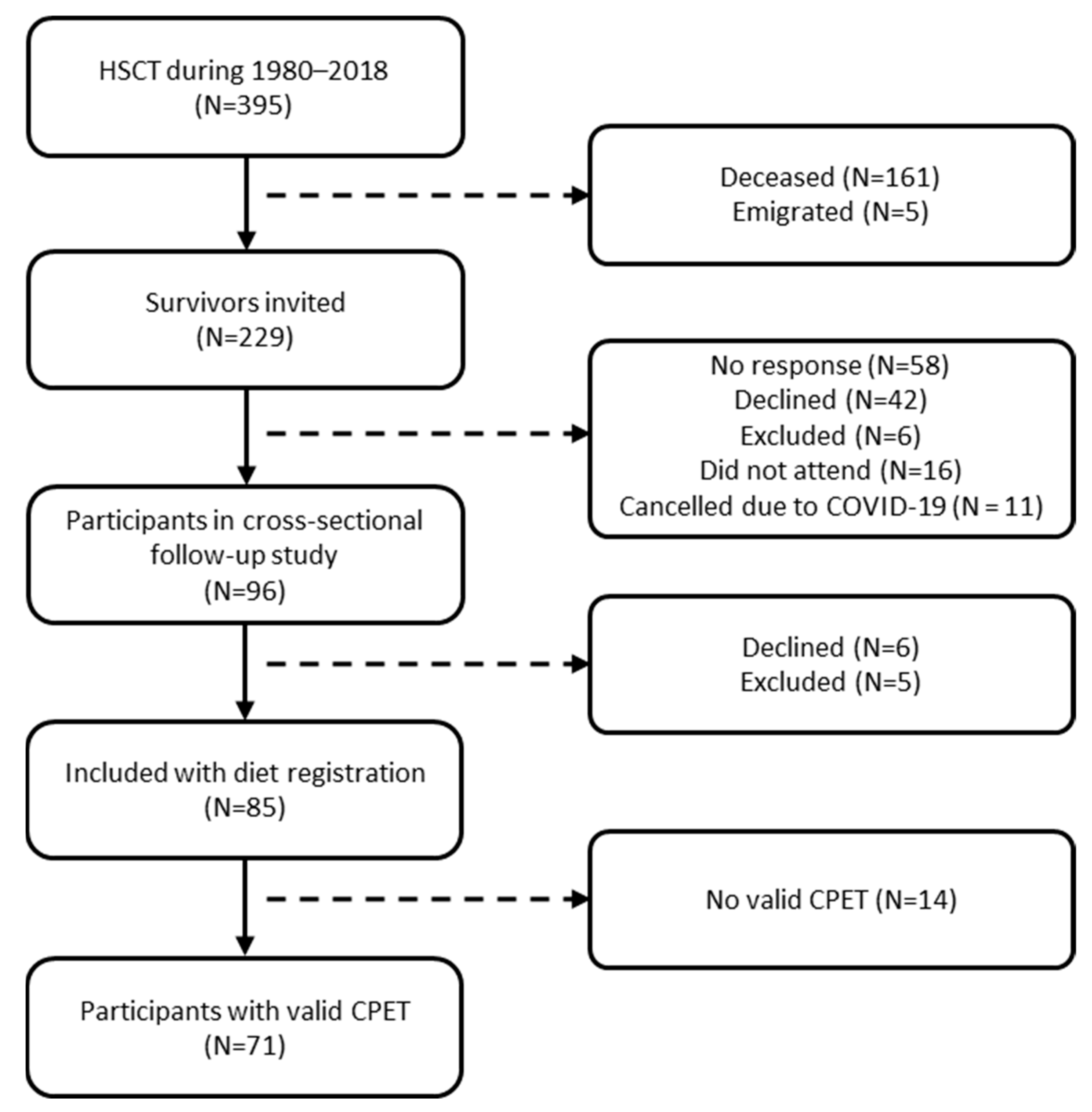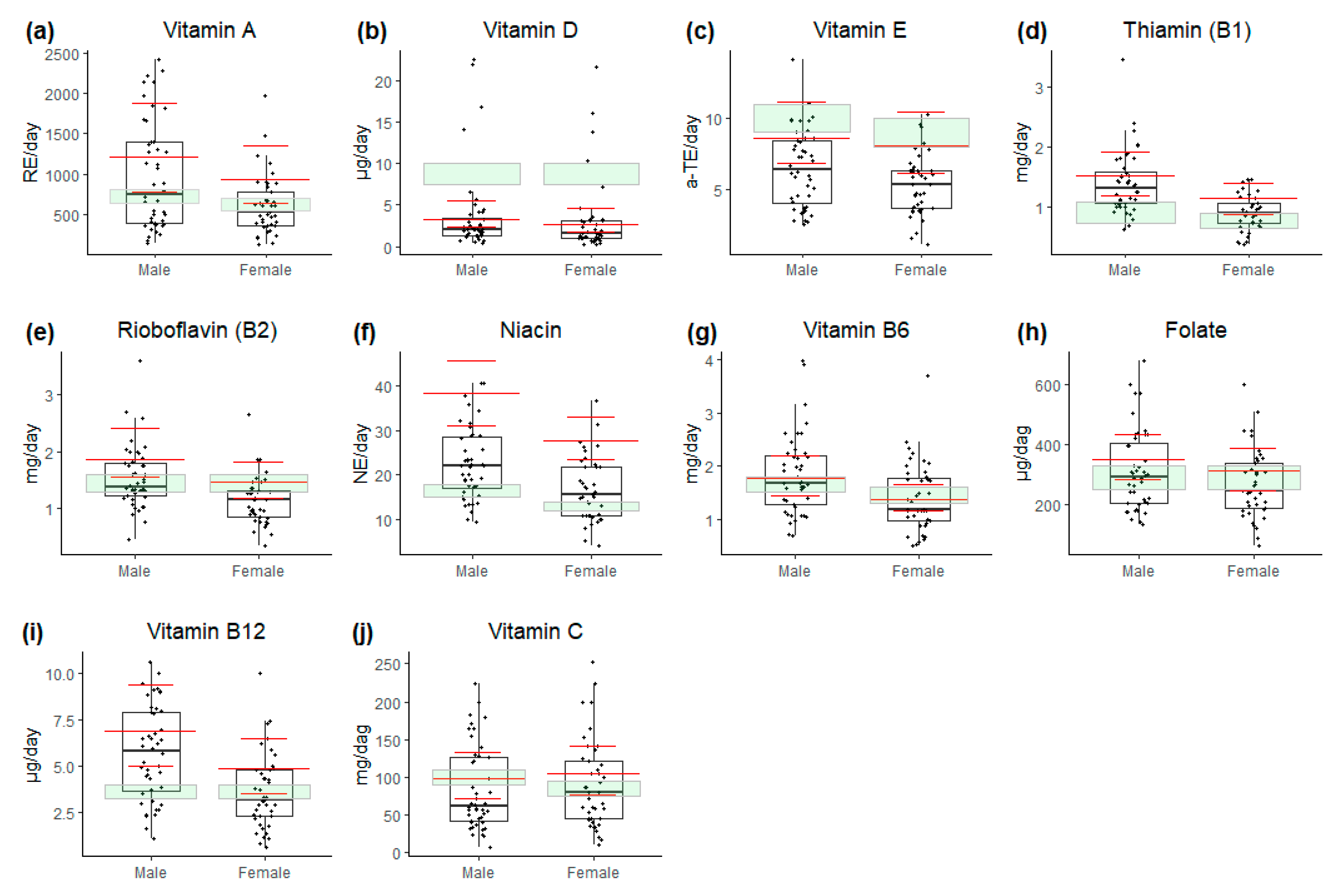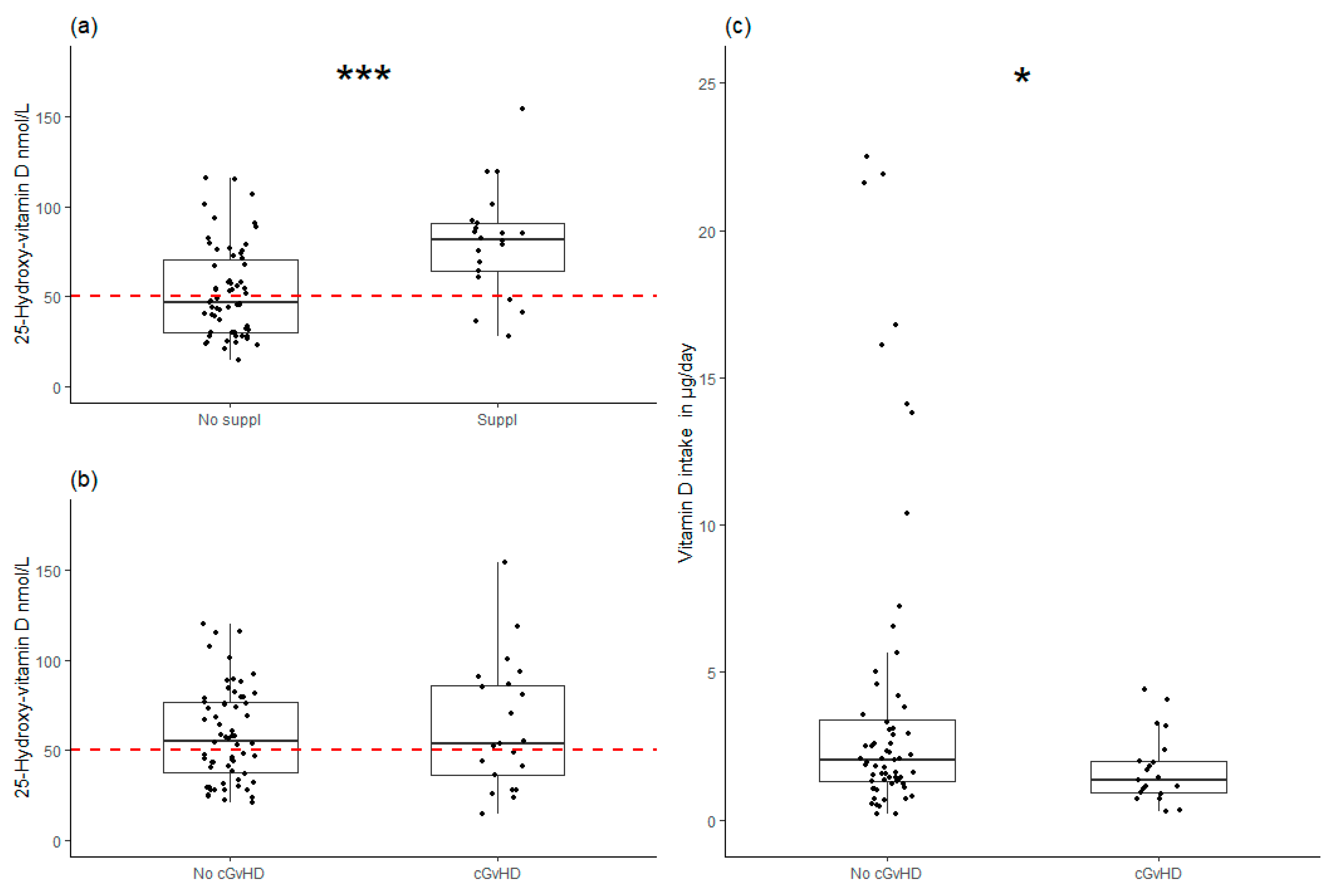Dietary Micronutrient Intake in Long-Term Survivors of Pediatric Hematopoietic Stem Cell Transplantation
Abstract
1. Introduction
2. Materials and Methods
2.1. Study Design and Population
2.2. Transplantation Variables
2.3. Dietary Record/Nutrition Intake Surveys
2.4. Cardiorespiratory Fitness Assessment
2.5. Physical Performance Tests
2.6. Body Composition
2.7. Plasma Analysis
2.8. Statistics
2.9. Ethics
3. Results
3.1. Vitamins
3.2. Vitamin D Plasma Levels and cGvHD
3.3. Minerals
3.4. Body Composition
3.5. Cardiorespiratory Fitness and Physical Performance
3.6. Micronutrients in Relation to Energy Intake
4. Discussion
5. Conclusions
Author Contributions
Funding
Institutional Review Board Statement
Informed Consent Statement
Data Availability Statement
Acknowledgments
Conflicts of Interest
Abbreviations
| Abbreviation | Full term |
| HSCT | Hematopoietic stem cell transplantation |
| TBI | Total body irradiation |
| aGvHD | Acute graft versus host disease |
| HLA | Human leukocyte antigen |
| cGvHD | Chronic graft versus host disease |
| RI | Recommended intake |
| AI | Adequate intake |
| AR | Average Requirement |
| CPET | Cardiopulmonary exercise test |
| VO2 peak | Maximal oxygen uptake |
| BMD | Bone Mineral Density |
| DXA | Dual-Energy X-ray Absorptiometry |
| SMI | Skeletal Muscle Index |
| ASM | Appendicular skeletal muscle mass |
| RE | Retinol equivalents |
| α-TE | Alpha-tocopherol equivalents |
| NE | Niacin equivalents |
| CI | Confidence interval |
References
- Bresters, D.; van Gils, I.C.M.; Kollen, W.J.W.; Ball, L.M.; Oostdijk, W.; van der Bom, J.G.; Egeler, R.M. High burden of late effects after haematopoietic stem cell transplantation in childhood: A single-centre study. Bone Marrow Transplant. 2010, 45, 79–85. [Google Scholar] [CrossRef]
- Eissa, H.M.; Lu, L.; Baassiri, M.; Bhakta, N.; Ehrhardt, M.J.; Triplett, B.M.; Green, D.M.; Mulrooney, D.A.; Robison, L.L.; Hudson, M.M.; et al. Chronic disease burden and frailty in survivors of childhood HSCT: A report from the St. Jude Lifetime Cohort Study. Blood Adv. 2017, 1, 2243–2246. [Google Scholar] [CrossRef] [PubMed]
- Morrison, C.F.; Drake, S.; Basile, N.L.; Horn, M.J.; Lambert, J.; Myers, K.C.; Pai, A.L. Symptoms of survivors of pediatric hematopoietic stem cell transplant by age, sex, and transplant type. J. Pediatr. Hematol. Oncol. Nurs. 2022, 39, 277–289. [Google Scholar] [CrossRef] [PubMed]
- Logan, R.M.; Stringer, A.M.; Bowen, J.M.; Yeoh, A.S.-J.; Gibson, R.J.; Sonis, S.T.; Keefe, D.M.K. The role of pro-inflammatory cytokines in cancer treatment-induced alimentary tract mucositis: Pathobiology, animal models and cytotoxic drugs. Cancer Treat. Rev. 2007, 33, 448–460. [Google Scholar] [CrossRef]
- Pontoppidan, P.L.; Jordan, K.; Carlsen, A.L.; Uhlving, H.H.; Kielsen, K.; Christensen, M.; Ifversen, M.; Nielsen, C.H.; Sangild, P.; Heegaard, N.H.H.; et al. Associations between gastrointestinal toxicity, microRNA and cytokine production in patients undergoing myeloablative allogeneic stem cell transplantation. Int. Immunopharmacol. 2015, 25, 180–188. [Google Scholar] [CrossRef] [PubMed]
- Jordan, K.; Pontoppidan, P.; Uhlving, H.H.; Kielsen, K.; Burrin, D.G.; Weischendorff, S.; Christensen, I.J.; Jørgensen, M.H.; Heilmann, C.; Sengeløv, H.; et al. Gastrointestinal toxicity, systemic inflammation, and liver biochemistry in allogeneic hematopoietic stem cell transplantation. Biol. Blood Marrow Transplant. 2017, 23, 1170–1176. [Google Scholar] [CrossRef]
- McNeer, J.L.; Kletzel, M.; Rademaker, A.; Alford, K.; O’Day, K.; Schaefer, C.; Duerst, R.; Jacobsohn, D.A. Early elevation of C-reactive protein correlates with severe infection and nonrelapse mortality in children undergoing allogeneic stem cell transplantation. Biol. Blood Marrow Transplant. 2010, 16, 350–357. [Google Scholar] [CrossRef]
- Fuji, S.; Mori, T.; Khattry, N.; Cheng, J.; Do, Y.R.; Yakushijin, K.; Kohashi, S.; Fukuda, T.; Kim, S.-W.; on behalf of the Nutritional Support Working Group of the Asian Pacific Bone Marrow Transplantation. Severe weight loss in 3 months after allogeneic hematopoietic SCT was associated with an increased risk of subsequent non-relapse mortality. Bone Marrow Transplant. 2015, 50, 100–105. [Google Scholar] [CrossRef]
- Schots, R.; Kaufman, L.; Van Riet, I.; Lacor, P.; Trullemans, F.; De Waele, M.; Van Camp, B. Monitoring of C-reactive protein after allogeneic bone marrow transplantation identifies patients at risk of severe transplant-related complications and mortality. Bone Marrow Transplant. 1998, 22, 79–85. [Google Scholar] [CrossRef][Green Version]
- Gerbek, T.; Thomsen, B.L.; Muhic, E.; Christiansen, T.; Sørensen, K.; Ifversen, M.; Kofoed, K.; Müller, K. Metabolic syndrome as a late effect of childhood hematopoietic stem cell transplantation—A thorough statistical evaluation of putative risk factors. Pediatr. Transplant. 2023, 27, e014530. [Google Scholar] [CrossRef]
- Muhic, E.; Mathiesen, S.; Nielsen, M.M.; Suominen, A.; Sørensen, K.; Ifversen, M.; Nolsöe, R.L.; Pedersen, K.M.; Lähteenmäki, P.; Nordestgaard, B.G.; et al. Metabolic syndrome in male survivors of pediatric allogeneic hematopoietic stem cell transplantation: Impact of total body irradiation, low-grade inflammation, and hypogonadism. Transplant. Cell Ther. 2021, 27, e1–e778. [Google Scholar] [CrossRef]
- Bielorai, B.; Weintraub, Y.; Hutt, D.; Hemi, R.; Kanety, H.; Modan-Moses, D.; Goldstein, G.; Hadar, D.; Lerner-Geva, L.; Toren, A.; et al. The metabolic syndrome and its components in pediatric survivors of allogeneic hematopoietic stem cell transplantation. Clin. Transplant. 2017, 31, e12903. [Google Scholar] [CrossRef]
- Nielsen, M.M.; Mathiesen, S.; Suominen, A.; Sørensen, K.; Ifversen, M.; Mølgaard, C.; Lähteenmäki, P.M.; Juul, A.; Jahnukainen, K.; Müller, K. Altered body composition in male long-term survivors of paediatric allogeneic haematopoietic stem cell transplantation: Impact of conditioning regimen, chronic graft-versus-host disease and hypogonadism. Bone Marrow Transplant. 2021, 56, 457–460. [Google Scholar] [CrossRef] [PubMed]
- Nielsen, M.M.; Mathiesen, S.; Suominen, A.; Sørensen, K.; Ifversen, M.; Mølgaard, C.; Lähteenmäki, P.M.; Juul, A.; Jahnukainen, K.; Müller, K. Determinants of cardiorespiratory fitness in very long-term survivors of allogeneic hematopoietic stem cell transplantation: A national cohort study. Support. Care Cancer 2021, 29, 1959–1967. [Google Scholar] [CrossRef]
- Tichelli, A.; Passweg, J.; Wójcik, D.; Rovó, A.; Harousseau, J.-L.; Masszi, T.; Zander, A.; Békássy, A.; Crawley, C.; Arat, M.; et al. Late cardiovascular events after allogeneic hematopoietic stem cell transplantation: A retrospective multicenter study of the Late Effects Working Party of the European Group for Blood and Marrow Transplantation. Haematologica 2008, 93, 1203–1210. [Google Scholar] [CrossRef]
- Marott, S.C.W.; Nordestgaard, B.G.; Tybjærg-Hansen, A.; Benn, M. Components of the metabolic syndrome and risk of type 2 diabetes. J. Clin. Endocrinol. Metab. 2016, 101, 3212–3221. [Google Scholar] [CrossRef] [PubMed]
- Pedersen, L.L.; Gerbek, T.; Sørum, M.E.; Muhic, E.; Christiansen, T.; Kok, K.; Sørensen, K.; Mølgaard, C.; Müller, K. Dietary intake and risk of metabolic syndrome in long-term survivors of pediatric allogeneic hematopoietic stem cell transplantation. Bone Marrow Transplant. 2024, 59, 1710–1716. [Google Scholar] [CrossRef] [PubMed]
- Fridh, M.K.; Simonsen, C.; Schmidt-Andersen, P.; Nissen, A.A.; Christensen, J.F.; Larsen, A.; Mackey, A.L.; Larsen, H.B.; Müller, K. Cardiorespiratory fitness and physical performance after childhood hematopoietic stem cell transplantation: A systematic review and meta-analysis. Bone Marrow Transplant. 2021, 56, 2063–2078. [Google Scholar] [CrossRef]
- Glucksberg, H.; Storb, R.; Fefer, A.; Buckner, C.D.; Neiman, P.E.; Clift, R.A.; Lerner, K.G.; Thomas, E.D. Clinical manifestations of graft-versus-host disease in human recipients of marrow from HL-A-matched sibling donors. Transplantation 1974, 18, 295–304. [Google Scholar] [CrossRef]
- Carreras, E.; Dufour, C.; Mohty, M.; Kröger, N. (Eds.) The EBMT Handbook, 7th ed.; Springer: Berlin/Heidelberg, Germany, 2019. [Google Scholar] [CrossRef]
- Jagasia, M.H.; Greinix, H.T.; Arora, M.; Williams, K.M.; Wolff, D.; Cowen, E.W.; Palmer, J.; Weisdorf, D.; Treister, N.S.; Cheng, G.-S.; et al. National Institutes of Health Consensus Development Project on Criteria for Clinical Trials in Chronic Graft-versus-Host Disease: I. The 2014 Diagnosis and Staging Working Group Report. Biol. Blood Marrow Transplant. 2015, 21, 389–401.e1. [Google Scholar] [CrossRef]
- MADLOG. Available online: https://www.madlog.dk/ (accessed on 18 January 2022).
- Frida—Database Med Fødevaredata Udgivet DTU Fødevareinstituttet. Available online: https://frida.fooddata.dk/ (accessed on 16 March 2022).
- Pedersen, A.N.; Christensen, T.; Matthiessen, J.; Knudsen, V.K.; Rosenlund-Sørensen, M.; Biltoft-Jensen, A.; Hinsch, H.J.; Ygil, K.H.; Kørup, K.; Saxholt, E.; et al. Dietary Habits in Denmark 2011–2013, 1st ed.; DTU Fødevareinstituttet: Lyngby, Denmark, 2015. [Google Scholar]
- Blomhoff, R.; Andersen, R.; Arnesen, E.K.; JuelChristensen, J.; Eneroth, H.; Erkkola, M.; Halldórsson, P.I.; Heyer-Lund, A.; Lemming, E.W. Nordic Nutrition Recommendations 2023; Nordic Council of Ministers: Copenhagen, Denmark, 2023. [Google Scholar]
- Shephard, R.J.; Allen, C.; Benade, A.J.; Davies, C.T.; E Di Prampero, P.; Hedman, R.; E Merriman, J.; Myhre, K.; Simmons, R. The maximum oxygen intake. An international reference standard of cardiorespiratory fitness. Bull. World Health Organ. 1968, 38, 757–764. [Google Scholar]
- Abizanda, P.; Navarro, J.L.; García-Tomás, M.I.; López-Jiménez, E.; Martínez-Sánchez, E.; Paterna, G. Validity and usefulness of hand-held dynamometry for measuring muscle strength in community-dwelling older persons. Arch. Gerontol. Geriatr. 2012, 54, 21–27. [Google Scholar] [CrossRef] [PubMed]
- Podsiadlo, D.; Richardson, S. The timed “Up & Go”: A test of basic functional mobility for frail elderly persons. J. Am. Geriatr. Soc. 1991, 39, 142–148. [Google Scholar] [CrossRef]
- Bohannon, R. Sit-to-stand test for measuring performance of lower extremity muscles. Percept. Mot. Skills 1995, 80, 163–166. [Google Scholar] [CrossRef]
- Geiger, R.; Strasak, A.; Treml, B.; Gasser, K.; Kleinsasser, A.; Fischer, V.; Geiger, H.; Loeckinger, A.; Stein, J.I. Six-minute walk test in children and adolescents. J. Pediatr. 2007, 150, 395–399. [Google Scholar] [CrossRef] [PubMed]
- American Thoracic Society. ATS statement: Guidelines for the six-minute walk test. Am. J. Respir. Crit. Care Med. 2002, 166, 111–117. [Google Scholar] [CrossRef]
- Fan, B.; Shepherd, J.A.; Levine, M.A.; Steinberg, D.; Wacker, W.; Barden, H.S.; Ergun, D.; Wu, X.P. National Health and Nutrition Examination Survey whole-body dual-energy X-ray absorptiometry reference data for GE Lunar systems. J. Clin. Densitom. 2014, 17, 344–377. [Google Scholar] [CrossRef]
- Imboden, M.T.; Swartz, A.M.; Finch, H.W.; Harber, M.P.; Kaminsky, L.A. Reference standards for lean mass measures using GE dual energy X-ray absorptiometry in Caucasian adults. PLoS ONE 2017, 12, e0176161. [Google Scholar] [CrossRef] [PubMed]
- Eriksen, L.; Grønbæk, M.; Helge, J.W.; Tolstrup, J.S. Cardiorespiratory fitness in 16,025 adults aged 18–91 years and associations with physical activity and sitting time. Scand. J. Med. Sci. Sports 2016, 26, 1435–1443. [Google Scholar] [CrossRef]
- Gower, J.C. Some distance properties of latent root and vector methods used in multivariate analysis. Biometrika 1966, 53, 325–338. [Google Scholar] [CrossRef]
- R: The R Project for Statistical Computing. Available online: https://www.r-project.org/ (accessed on 16 March 2022).
- Cattoni, A.; Capitoli, G.; Casagranda, S.; Corti, P.; Adavastro, M.; Molinaro, A.; Di Gennaro, F.; Bonanomi, S.; Biondi, A.; Galimberti, S.; et al. Iron overload following hematopoietic stem cell transplantation: Prevalence, severity, and management in children and adolescents with malignant and nonmalignant diseases. Transplant. Cell Ther. 2023, 29, e1–e271. [Google Scholar] [CrossRef]
- Nissen, A.; Gerbek, T.; Fogelstrøm, K.; Schmidt-Andersen, P.; Sørensen, K.; Mackey, A.L.; Fridh, M.K.; Müller, K. Cardiorespiratory fitness, physical performance and metabolic syndrome in adult survivors of pediatric haematopoietic stem cell transplantation. Pediatr. Blood Cancer 2025, 72, e31684. [Google Scholar] [CrossRef]
- Farhadfar, N.; Kelly, D.L.; Mead, L.; Nair, S.; Colee, J.; Gatell, V.I.; Murthy, H.S.; Brown, R.A.; Hiemenz, J.W.; Hsu, J.W.; et al. Dietary intake and diet quality of hematopoietic stem cell transplantation survivors. Biol. Blood Marrow Transplant. 2020, 26, 1154–1159. [Google Scholar] [CrossRef] [PubMed]
- Zhang, F.F.; Ojha, R.P.; Krull, K.R.; Gibson, T.M.; Lu, L.; Lanctot, J.; Chemaitilly, W.; Robison, L.L.; Hudson, M.M. Adult survivors of childhood cancer have poor adherence to dietary guidelines. J. Nutr. 2016, 146, 2497–2505. [Google Scholar] [CrossRef]
- Mejborn, H.; Brot, C.; Boskov, H.; Koch, B.; Hyldstrup, L.; Mortensen, L.; Mosekilde, L.; Mølgård, C.; Petersen, T.; Rasmussen, S.E.; et al. D-vitaminstatus i den Danske Befolkning bør Forbedres; Ministeriet for Fødevarer, Landbrug og Fiskeri, Danmarks Fødevare-og Veterinærforskning: København, Denmark, 2004. [Google Scholar]
- Müller, K.; Oxholm, P.; Thymann, M.; Bendtzen, K. Abnormal vitamin D3 metabolism in patients with primary Sjogren’s syndrome. Ann. Rheum. Dis. 1990, 49, 682–684. [Google Scholar] [CrossRef] [PubMed]
- Müller, K.; Kriegbaum, N.J.; Baslund, B.; Sorensen, O.H.; Thymann, M.; Bentzen, K. Vitamin D3 metabolism in patients with rheumatic diseases: Low serum levels of 25-hydroxyvitamin D3 in patients with systemic lupus erythematosus. Clin. Rheumatol. 1995, 14, 397–400. [Google Scholar] [CrossRef] [PubMed]
- Bevans, M.; El-Jawahri, A.; Tierney, D.K.; Wiener, L.; Wood, W.A.; Hoodin, F.; Kent, E.E.; Jacobsen, P.B.; Lee, S.J.; Hsieh, M.M.; et al. National Institutes of Health Hematopoietic Cell Transplantation Late Effects Initiative: The Patient-Centered Outcomes Working Group Report. Biol. Blood Marrow Transplant. 2017, 23, 538–551. [Google Scholar] [CrossRef]
- Borchert-Mörlins, B.; Memaran, N.; Sauer, M.; Maecker-Kolhoff, B.; Sykora, K.-W.; Blöte, R.; Bauer, E.; Schmidt, B.M.W.; Melk, A.; Beier, R. Cardiovascular risk factors and subclinical organ damage after hematopoietic stem cell transplantation in pediatric age. Bone Marrow Transplant. 2018, 53, 983–992. [Google Scholar] [CrossRef]
- Mancin, S.; Cangelosi, G.; Matteucci, S.; Palomares, S.M.; Parozzi, M.; Sandri, E.; Sguanci, M.; Piredda, M. The role of vitamin D in hematopoietic stem cell transplantation: Implications for graft-versus-host disease-a narrative review. Nutrients 2024, 16, 2976. [Google Scholar] [CrossRef]
- Rodríguez-Gil, A.; Carrillo-Cruz, E.; Marrero-Cepeda, C.; Rodríguez, G.; Pérez-Simón, J.A. Effect of vitamin D on graft-versus-host disease. Biomedicines 2022, 10, 987. [Google Scholar] [CrossRef]
- Jula, A. Sodium—A systematic review for Nordic Nutrition Recommendations 2023. Food Nutr. Res. 2024, 68, 10319. [Google Scholar] [CrossRef] [PubMed]
- Armenian, S.H.; Chemaitilly, W.; Chen, M.; Chow, E.J.; Duncan, C.N.; Jones, L.W.; Pulsipher, M.A.; Remaley, A.T.; Rovo, A.; Salooja, N.; et al. National Institutes of Health Hematopoietic Cell Transplantation Late Effects Initiative: The Cardiovascular Disease and Associated Risk Factors Working Group Report. Biol. Blood Marrow Transplant. 2017, 23, 201–210. [Google Scholar] [CrossRef]
- Ghazzawi, H.A.; Hussain, M.A.; Raziq, K.M.; Alsendi, K.K.; Alaamer, R.O.; Jaradat, M.; Alobaidi, S.; Al Aqili, R.; Trabelsi, K.; Jahrami, H. Exploring the relationship between micronutrients and athletic performance: A comprehensive scientific systematic review of the literature in sports medicine. Sports 2023, 11, 109. [Google Scholar] [CrossRef] [PubMed]
- Oliveira, D.C.; Nogueira-Pedro, A.; Santos, E.W.; Hastreiter, A.; Silva, G.B.; Borelli, P.; Fock, R.A. A review of select minerals influencing the haematopoietic process. Nutr. Res. Rev. 2018, 31, 267–280. [Google Scholar] [CrossRef]
- Genuis, S.J.; Bouchard, T.P. Combination of micronutrients for bone (COMB) study: Bone density after micronutrient intervention. J. Environ. Public Health 2012, 2012, 354151. [Google Scholar] [CrossRef]
- Schimmer, A.D.; Minden, M.D.; Keating, A. Osteoporosis after blood and marrow transplantation: Clinical aspects. Biol. Blood Marrow Transplant. 2000, 6, 175–181. [Google Scholar] [CrossRef]
- Zmora, N.; Suez, J.; Elinav, E. You are what you eat: Diet, health and the gut microbiota. Nat. Rev. Gastroenterol. Hepatol. 2019, 16, 35–56. [Google Scholar] [CrossRef]
- Spohr, P.; Scharf, S.; Rommerskirchen, A.; Henrich, B.; Jäger, P.; Klau, G.W.; Haas, R.; Dilthey, A.; Pfeffer, K. Insights into gut microbiomes in stem cell transplantation by comprehensive shotgun long-read sequencing. Sci. Rep. 2024, 14, 53506. [Google Scholar] [CrossRef] [PubMed]
- Khalil, Z.; Maher, S. The impact of microbiome dysbiosis on hematopoietic stem cell transplantation outcomes: A review article. Cureus 2024, 16, e63995. [Google Scholar] [CrossRef]
- Heitmann, B.L.; Lissner, L.; Osler, M. Do we eat less fat, or just report so? Int. J. Obes. 2000, 24, 435–442. [Google Scholar] [CrossRef]





| Characteristics | |
|---|---|
| Included survivors, n Males, n (%) | 85 44 (52) |
| Patient-related characteristics, median (range) | |
| Age at follow-up, years | 30.4 (19.6–53.0) |
| Weight, kg | 63.0 (36.0–98.6) |
| BMI, kg/m2 | 23.1 (15.6–31.9) |
| Time from transplantation to examination, years | 19.9 (5.9–36.9) |
| Age at transplantation, years | 10.9 (0.4–17.9) |
| Donor age, years | 11.5 (1.7–47.6) |
| Diagnosis, n (%) | |
| Acute leukemia | 42 (49) |
| Other malignant disease | 15 (18) |
| Benign disease | 28 (33) |
| Donor type, n (%) | |
| HLA-identical sibling | 45 (53) |
| Matched unrelated donor | 23 (27) |
| Others | 17 (20) |
| Graft type, n (%) | |
| Bone marrow | 78 (92) |
| Peripheral blood | 2 (2) |
| Umbilical cord blood | 5 (6) |
| Conditioning, n (%) | |
| TBI-based conditioning regimes | 45 (53) |
| BU + CY | 24 (28) |
| Other | 16 (19) |
| GvHD, n (%) | |
| Acute GvHD | |
| Grade 0-I | 60 (70) |
| Grade II-IV | 25 (30) |
| Chronic GvHD | |
| Yes | 21 (25) |
| No | 64 (75) |
Disclaimer/Publisher’s Note: The statements, opinions and data contained in all publications are solely those of the individual author(s) and contributor(s) and not of MDPI and/or the editor(s). MDPI and/or the editor(s) disclaim responsibility for any injury to people or property resulting from any ideas, methods, instructions or products referred to in the content. |
© 2025 by the authors. Licensee MDPI, Basel, Switzerland. This article is an open access article distributed under the terms and conditions of the Creative Commons Attribution (CC BY) license (https://creativecommons.org/licenses/by/4.0/).
Share and Cite
Pedersen, L.L.; Sørum, M.E.; Nissen, A.; Gerbek, T.; Kok, K.; Sørensen, K.; Fridh, M.K.; Mølgaard, C.; Müller, K.G. Dietary Micronutrient Intake in Long-Term Survivors of Pediatric Hematopoietic Stem Cell Transplantation. Nutrients 2025, 17, 1663. https://doi.org/10.3390/nu17101663
Pedersen LL, Sørum ME, Nissen A, Gerbek T, Kok K, Sørensen K, Fridh MK, Mølgaard C, Müller KG. Dietary Micronutrient Intake in Long-Term Survivors of Pediatric Hematopoietic Stem Cell Transplantation. Nutrients. 2025; 17(10):1663. https://doi.org/10.3390/nu17101663
Chicago/Turabian StylePedersen, Louise Lindkvist, Maria Ebbesen Sørum, Anne Nissen, Tina Gerbek, Karin Kok, Kaspar Sørensen, Martin Kaj Fridh, Christian Mølgaard, and Klaus Gottlob Müller. 2025. "Dietary Micronutrient Intake in Long-Term Survivors of Pediatric Hematopoietic Stem Cell Transplantation" Nutrients 17, no. 10: 1663. https://doi.org/10.3390/nu17101663
APA StylePedersen, L. L., Sørum, M. E., Nissen, A., Gerbek, T., Kok, K., Sørensen, K., Fridh, M. K., Mølgaard, C., & Müller, K. G. (2025). Dietary Micronutrient Intake in Long-Term Survivors of Pediatric Hematopoietic Stem Cell Transplantation. Nutrients, 17(10), 1663. https://doi.org/10.3390/nu17101663








